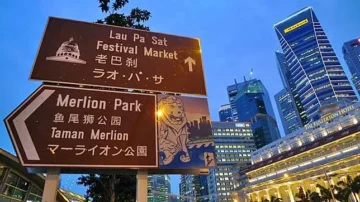by Eric Feigenbaum

In 1965, Singapore’s Founding Prime Minister, Lee Kuan Yew corrected an Australian news reporter:
“I am not in fact Chinese. I am Malaysian. I am by race Chinese. I am no more Chinese than you are an Englishman.” He refined the example on other occasions, eventually saying he was “no more Chinese than President Kennedy was an Irishman”.
Like his examples, Lee grew up speaking English – it was a first language for him along with Malay.

In those days, it was far from clear English would continue as a dominant language in the countries spun out of British Malaya, let alone that it would later create an unexpected cascade of successes for Singapore.
One of the pressing issues of Singapore’s early days was the cultural tension related to choosing the fledgling country’s language. The 500 square kilometer island was nearly empty when the British claimed it in the 1820’s, turning it into an open-port city with a very loose immigration policy. When considering the issue in 1965, few if any imagined their choice of language could become an economic asset of untold dimensions.
Even prior to Singapore’s inception, the question of a national language among the major three ethnicities – Chinese, Malay and Tamil Indian – was charged. It highlighted just how much Singapore was a land of immigrants – migrants really – who left their home countries in search of work and opportunity. There was no “Singaporean” ethnicity – just a collection of people who called Singapore home.
Much agonizing led to the Singaporean version of the Connecticut Compromise. Singapore would make Mandarin, Malay, Tamil and English all official, legal languages that could be used in court or on legal documents. Yet it would also make English – the language of no one ethnicity – the working and educational language of Singapore. One common tongue everyone could share.
Technically, Singapore made Malay the national language to honor “the sons of the soil” whose ethnicity was most tied to the land. However, that is primarily ceremonial.
Creating an English-speaking society caused everyone to share an equal burden of discomfort – having to bend to a language different than what they spoke at home. Singaporean schools also teach “Mother Tongue” classes in which – at least originally – students took a class a day studying their own ethnic languages. Eventually students were allowed to take any Mother Tongue of their choosing – meaning a Chinese ethnic can study Malay or an Indian ethnic can study Mandarin.
This thoughtful balance allowed people to invest themselves as Singaporean while still taking pride in their ethnic identities. The idea of accepted and valued cultural diversity is inherent to the country.
“If we were monolingual in our mother tongues, we would not make a living. Becoming monolingual in English would have been a setback,” Lee wrote in his memoirs. “We would have lost our cultural identity, that quiet confidence about ourselves and our place in the world.”
Politically, the Indian population had the most to gain from English. Without English, the language choice was between Chinese and Malay – leaving the Tamil speaking population forced to accept another local culture’s language. Given the Tamils were brought by the British – largely to take civil service and policing jobs – English was a much more comfortable and acceptable medium for them.
“We need a common language,” Lee explained. “We solved this by making everybody learn not one but two languages, English and the mother tongue. English is not any group’s mother tongue, so no advantage is gained or lost by any one group.”
As time passed, the Singaporean government saw their language policy was an asset to be extolled.
“The mono-linguist is more likely to be a language chauvinist and a bigot,” Lee said in a speech, “He only sees the world through one eye. He does not have binocular vision to see the world in depth, to realize that there are as rich, if not richer, worlds of human experience and knowledge, all expressed in beautiful words, elegantly, vividly and fluently in other languages.”
The social stability was success enough – but then something unexpected, but foreseeable happened: English attracted foreign direct investment. American, British, Australian and even European companies found Singaporeans easy to communicate with. Singapore realized it had a natural strength in being not just a linguistic, but a cultural bridge between East and West. Singaporeans had a foot in each world. This became a particular advantage as China opened to the world.
Lee observed as late as 2017:
China has more handicaps going forward and more obstacles to overcome than most observers recognize. Chief among these are… cultural habits that limit imagination and creativity, rewarding conformity; a language that shapes thinking through epigrams and 4,000 years of texts that suggest everything worth saying has already been said, and said better by earlier writers; a language that is exceedingly difficult for foreigners to learn sufficiently to embrace China and be embraced by its society; and severe constraints on its ability to attract and assimilate talent from other societies in the world.
Not necessarily by design, Singapore avoided these pitfalls in large part by taking stock and embracing some of the advantages given to it by a century and a half of British rule. Unlike so many new countries decolonized in the aftermath of the Second World War, Singapore didn’t allow anti-colonial sentiment to result in throwing the baby out with the bathwater. The British Empire had been highly successful and its accomplishments, tactics and innovations extraordinary valuable.
Singapore’s early leaders like Lee Kuan Yew, Boon Keng Swee, S Rajaratnam and Edmund Barker received their degrees in Britain and appreciated British government, economics and society. As they built an independent Singapore, they chose to stand on the shoulders on their British inheritance while not forsaking the cultures of the peoples of Singapore.
Accordingly, Singapore benefitted from the flexibility and creativity of the English language, Western-style higher-education including research institutions and science, and beliefs in free-market capitalism underpinned by strong property rights. Only, they mixed in what Lee often referred to as “Asian values” – a sort of catch-all term for a set of more conservative outlooks that often fit with the collectivist impulses within the cultures that made up Singapore.
Lee described the contrast of “Asian Values” against Western ones as: “The main object is to have a well-ordered society so that everybody can have maximum enjoyment of his freedoms. This freedom can only exist in an ordered state and not in a natural state of contention and anarchy.”
Singapore’s calm, well-manicured streets are physical reflections of this principle as are its cleanliness, efficiency and even its clear, well-lit signage.
Interestingly, these “Asian” differences made a positive impression on Western investors. Some of Singapore’s earliest foreign investors included Hewlett Packard, National Semiconductor and Texas Instruments who found a clean, orderly country of well-spoken, educated leaders highly enticing.
As Singapore’s economy progressed and technology further developed, it became clear to Western software, technology, pharmaceutical and bio-tech companies that Singapore had unique advantages within Asia. Not only could Singaporeans speak English and other key languages of the region including Chinese, Malay, Indonesian, Tamil and Hindi – but they understood the thinking and outlooks of this array of people. Singaporeans could relate to Americans and British, but also to Chinese, Malays, Indonesians and Indians. They didn’t just translate words – but concepts, outlooks and cultures.
Equally important – and distinct from almost every other Asian country – Singapore uses British Common Law and shared the same foundation of property rights – including intellectual property rights – as the United States and the United Kingdom, making Singapore a safe place for a post-industrial company to do business.
In the end, English became one of Singapore’s greatest assets. It created equality and unification from within while externally positioning the small island nation as a global economic powerhouse with the fifth highest Per Capita GDP in the world – higher than the United States, United Kingdom, France, United Arab Emirates and falling mainly behind specialty banking enclaves like Switzerland, Liechtenstein and the Cayman Islands.
The heart of Singapore’s success was how English plays the role of a common platform – something all Singaporeans know and use – without becoming a single, dominating language demanding cultural deference or homogeneity. One country – many identities and perspectives.
***
Enjoying the content on 3QD? Help keep us going by donating now.
